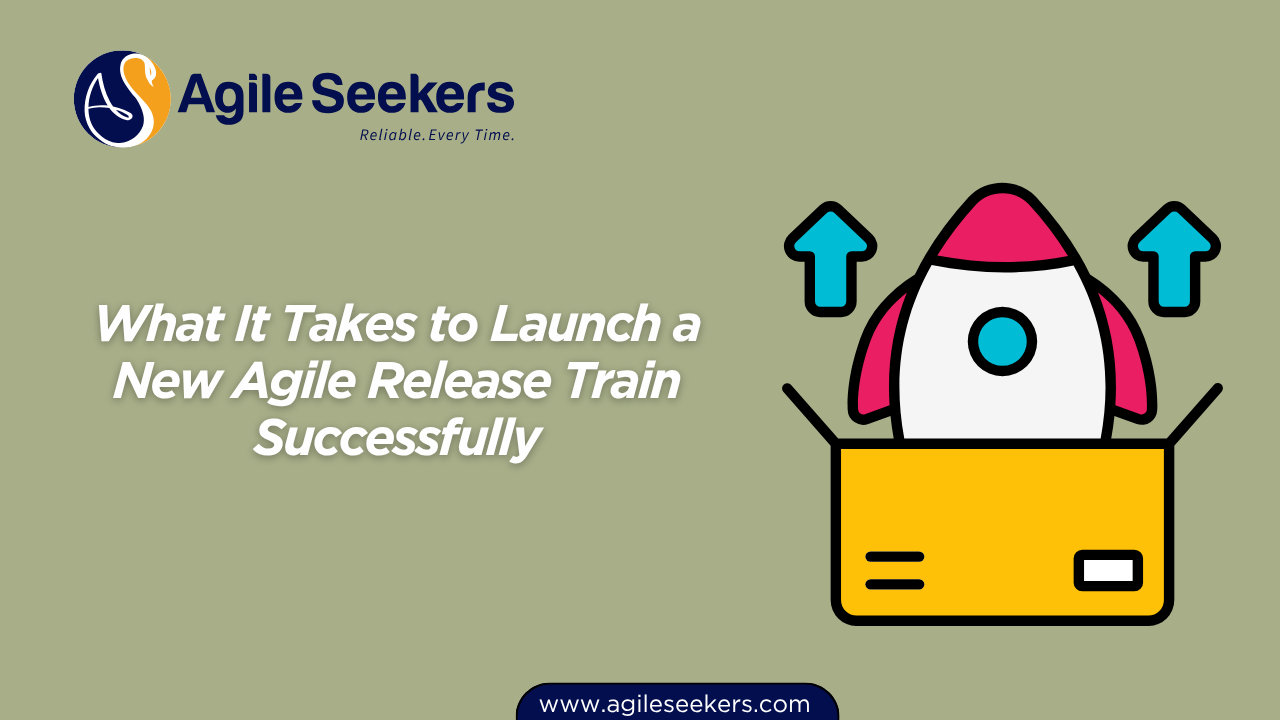What It Takes to Launch a New Agile Release Train Successfully

Launching a new Agile Release Train (ART) is a major milestone in any SAFe® implementation. It’s not just about scheduling a Program Increment (PI); it’s about aligning teams, preparing leaders, enabling systems thinking, and ensuring readiness at every level of the organization. A successful launch sets the tone for continuous flow, sustainable delivery, and long-term agility.
Let’s break down what it truly takes to launch an Agile Release Train with precision and clarity.
1. Establish the Need and Select the Value Stream
Before launching, identify the value stream that will benefit most from the ART. This means understanding where the most customer value lies and which part of the organization is ready to adopt Lean-Agile practices.
Use value stream mapping techniques to:
-
Define operational vs. development value streams.
-
Identify major delays, handoffs, or wait times.
-
Determine where ARTs can streamline flow and reduce time-to-market.
This foundational step often involves Leading SAFe® Agilist Certification Training to enable leadership alignment and shared understanding of how to apply SAFe in context.
2. Define the ART’s Scope and Vision
Once the value stream is clear, define:
-
The ART’s purpose – what business capabilities will it deliver?
-
The ART’s stakeholders – including Business Owners, customers, and system architects.
-
The ART’s boundaries – including team participation, solution areas, and dependencies.
This clarity prevents scope creep, unclear objectives, or misaligned roles later.
3. Identify Agile Teams and Train Them
Each ART consists of 5–12 Agile teams. Every team must be trained, aligned, and prepared to work with a shared backlog and cadence.
Key activities here:
-
Form cross-functional Agile teams, ensuring they can deliver end-to-end value.
-
Train all team members in the SAFe Scrum Master Certification or SAFe Product Owner/Product Manager (POPM) Certification depending on their roles.
-
Reinforce team-level agility using SAFe's core competencies such as Team and Technical Agility.
Training isn’t optional—it builds shared vocabulary, principles, and expectations.
4. Prepare the Program Backlog
The Program Backlog fuels the ART. Without it, teams will enter PI Planning blind. The Release Train Engineer (RTE), Product Management, System Architect, and Business Owners must prepare:
-
Features that are solution-aligned, estimable, and prioritized.
-
A shared understanding of enabler work, tech dependencies, and architectural runway.
The SAFe POPM certification equips roles like Product Managers with the skills to lead this effort effectively.
External reference: SAFe Program Backlog Guidance (scaledagileframework.com)
5. Identify Roles and Train Leadership
A successful ART hinges on clear leadership roles. At a minimum, the following should be trained and defined:
-
Release Train Engineer (RTE) – the servant leader and facilitator of the train.
-
Product Management – responsible for backlog prioritization and feature flow.
-
System Architect/Engineer – ensuring technical alignment and enabler definition.
-
Business Owners – stakeholders who define value and approve PI objectives.
Leadership roles can be prepared through the SAFe Release Train Engineer Certification Training and SAFe Advanced Scrum Master Certification Training for those taking broader facilitation roles.
6. Conduct a Readiness Checklist
Before launching, conduct an ART Readiness Review. This checklist includes:
-
Agile teams formed and trained.
-
Backlog prepared and prioritized.
-
Roles trained and responsibilities clarified.
-
PI Planning logistics finalized (tooling, facilities, tech support).
-
Dependencies identified and discussed.
Skipping this step often results in misalignment during the first PI.
7. Plan and Facilitate the First PI Planning Event
PI Planning is the heartbeat of the ART. It brings all teams, stakeholders, and leadership together to align on a common vision and plan.
Key success factors:
-
Effective facilitation by the RTE.
-
Clear business context and solution vision from leaders.
-
Teams planning in iterations with visible risks and dependencies.
-
Collective confidence vote at the end.
PI Planning also sets the cultural tone. It’s the first real moment of alignment at scale. This is where SAFe Scrum Masters play a key role in facilitating breakout sessions and resolving team-level challenges.
8. Establish ART Cadence and Events
Post-launch, the ART should enter a steady rhythm of events including:
-
System Demos – to show integrated value across teams.
-
Scrum of Scrums and PO Syncs – for coordination.
-
Inspect & Adapt (I&A) – to drive relentless improvement.
The RTE helps establish this cadence. Teams must be guided on how to sync sprint boundaries, share metrics, and handle cross-team blockers.
Reference: Scaled Agile ART Event Guidance
9. Align Tooling and Metrics
Ensure the ART uses shared Agile tooling (Jira, Rally, etc.) to track features, velocity, and dependencies across teams. Key metrics to establish include:
-
Flow metrics (e.g., flow time, flow efficiency)
-
PI Objective tracking (planned vs. achieved)
-
Feature cycle time
-
ART predictability
Make metrics visible to everyone. It promotes transparency and motivates improvement.
10. Foster a Culture of Continuous Learning
Even after launch, learning must continue. Hold retrospectives not just at team level but at ART level. Encourage communities of practice. Promote certifications that keep knowledge current and deepen roles.
Certifications like the Leading SAFe® Agilist Certification Training help leaders continually refine their understanding of Lean-Agile transformation as the ART matures.
Final Thoughts
Launching an ART is not a one-time technical setup—it’s a shift in mindset, leadership, team structure, and delivery culture. When done right, it unlocks faster delivery, better collaboration, and a sharper focus on customer value.
It takes the right people, training, backlog, structure, and vision to launch successfully. But most of all, it takes intentional planning. If your teams are aligned, trained, and supported by strong leadership, your ART can become the engine that drives enterprise agility forward.
Also read - How Release Trains Enable Continuous Delivery in SAFe Environments
Also see - Role of Release Train Engineer in Coordinating Agile Teams of Teams




















